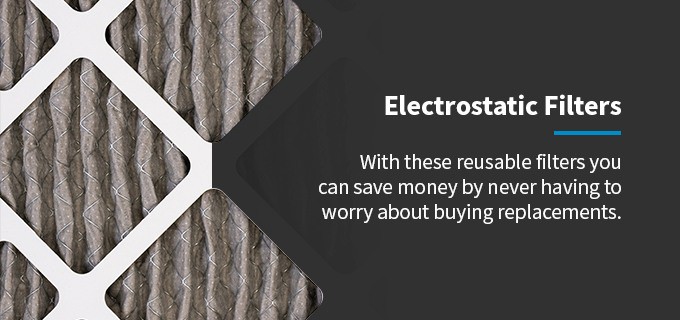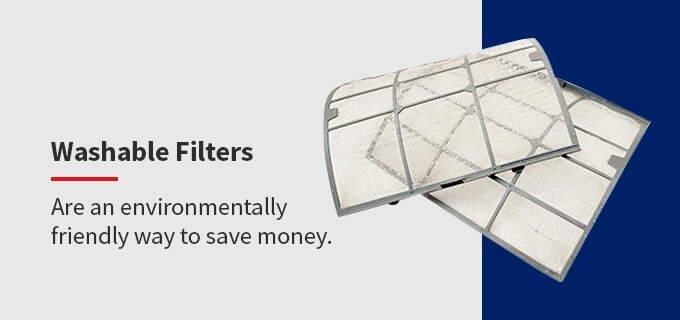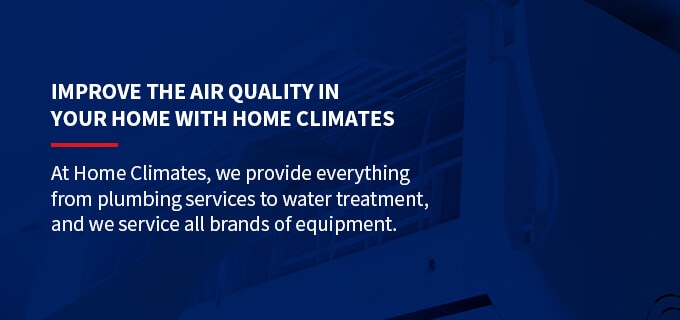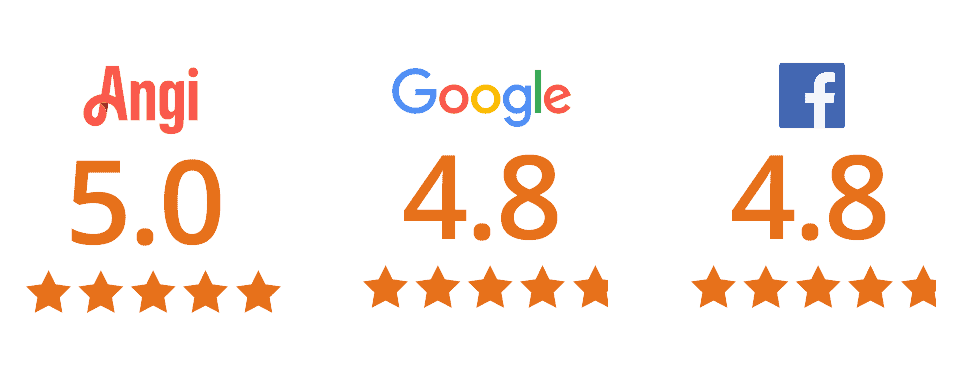Air Filter Types
Jun 16, 2020

Indoor air quality is a crucial element for any homeowner, especially if members of your household have respiratory problems. Proper HVAC filters can make the difference between stuffy air filled with pollutants and clean air that’s healthy and easy to breathe. Understanding the different air filter types for homes is the first step to getting the improved indoor air quality you deserve.
What Are the Different Kinds of Air Filters?
There are seven commonly used home air filter types:
- HEPA filters
- UV light filters
- Electrostatic filters
- Washable filters
- Media filters
- Spun glass filters
- Pleated filters
Each of these filters has its own set of pros and cons, which vary based on your goal for your home. Some people need HVAC system filters that will keep the air free of allergens and other pollutants, while others just need a basic filter to get the job done. Generally, high-efficiency filters that are also cost-effective are best for homes, but other considerations should include whether there are pets in the home, whether mold or mildew is a threat and how often the filters should be changed.
The materials air filters are made of vary from fabrics to fiberglass. Filters are also rated using the Minimum Efficiency Reporting Value (MERV), which was developed by the American Society of Heating and Refrigerating and Air Conditioning Engineers (ASHRAE). The ratings range from 1 to 16 and give you an idea of how well the filter can trap pollutants that are as small as 0.3 microns and as large as 10 microns, with 16 being the most effective.
Air Quality Services in Central PA
Which Filter Type Is Best for Your Home?
Not all filters are built the same, so choosing the right filter depends on what you need to purify from the air. You’ll also want to consider factors like the cost of the filters. It’s wise to speak to an HVAC professional before making any decisions about air filters. To help gather information and weigh your options, you can compare the basic pros and cons of each filter type. Let’s take a look at each filter type and its characteristics to narrow down the types that may be a good fit for your home.
1. HEPA Filters
High-efficiency particulate air (HEPA) filters are recommended by the U.S. Department of Health because they are able to remove at least 99.97% of airborne allergens and pollutants — including mold spores and dust that are as small as 0.3 microns. With a MERV rating nearing 16, HEPA filters provide the highest protection for your home. They’re able to remove even the smallest microns or airborne particles, including tobacco and bacteria.
Those who live with allergies or other respiratory issues may benefit from HEPA filters the most. These filters do need to be adjusted by a contractor to fit your specific HVAC system.
HEPA FILTERS PROS AND CONS
- Pros: The biggest pro of HEPA filters is how effectively they purify the air. The design of these filters makes it ideal for capturing larger pollutants, like pet dander and pollen. These filters are also fairly cost-effective and only need to be changed every few years.
- Cons: While they’re great at ridding your home of most pollutants, there are still some pollutants HEPA filters are helpless against. Fumes, gasses and odors are too small for HEPA filters, and pollutants like mold spores may settle on the filter itself, reducing its effectiveness and likely requiring replacement sooner than expected.
2. UV Filters
As their name suggests, UV filters use short-wave ultraviolet light to kill bacteria and viruses. When air passes through the HVAC unit, the UV lamps disinfect it with germicidal radiation. UV filters are excellent for killing microorganisms that could be hazardous to your health, including mold spores.
One potential danger of UV filters is that they can transform oxygen into ozone, which can be hazardous for your health. Even low amounts of ozone can cause coughing and chest pain, while higher amounts of it can lead to worsening of existing respiratory diseases, like asthma.
Though UV filters are great at eliminating bacteria and viruses, they’re not as efficient when it comes to screening against pollutants like dust. This is why they are often part of a larger filtration mechanism, which includes HEPA air filters. The UV light is invisible to the human eye, and the lightbulbs generally need to be replaced every year, depending on the make and model of the HVAC system.
UV FILTERS PROS AND CONS
- Pros: The UV light used in these filters is able to kill tough pollutants like mold and germs, giving you exceptional indoor air quality to help prevent diseases and respiratory illnesses.
- Cons: On top of being fairly costly to install, UV filters are unable to rid the air of more common pollutants, like dust or allergens. They’re also ineffective against gases, fumes and cigarette smoke.
3. Electrostatic Filters

Using small cotton and paper fibers, electrostatic filters create static that acts as a magnet for dust and other airborne particles. The magnetism is strong enough that it keeps these particles from spreading throughout your home, making them one of the best choices for those who need a filter that can combat allergens.
An added bonus for electrostatic filters is they are available as disposable as well as reusable. When it comes time to change the filters, you can decide whether to wash and reuse them or toss them and get brand new ones.
Air Quality Services in Central PA
ELECTROSTATIC FILTERS PROS AND CONS
- Pros: Regardless of whether you choose the disposable or reusable option, these filters are some of the most cost-effective options on the market. An added bonus of reusable filters is that you can save money by never having to worry about buying replacements. Plus, these filters are great at improving indoor air quality.
- Cons: While this filter handles smaller pollutants, it may struggle to filter larger ones, such as dust or mold spores. This makes electrostatic filters a poor choice for people who have respiratory issues.

4. Washable Filters
While certain types of air filters come with reusable and disposable options, washable filters are an environmentally friendly way to save money. The initial price of this air filter type for HVAC systems is high, but it should be viewed as an investment that will last for many years. The initial price is likely all you’ll have to pay as you can simply wash and reuse the filter over and over again instead of buying new ones every few months.
Washable filters need to be maintained well to ensure they work as they should. As one of the main types of air filters, they come with maintenance instructions that should be followed. It’s very important to make sure the filter is fully dry before putting it back in. Even the slightest bit of moisture left can lead to mold and mildew developing on the filter and being expelled into the air you breathe.
While these filters have a low MERV rating, they are a great long-term investment for someone who doesn’t have strong preferences about HVAC filter types and doesn’t need any specialty filters.
WASHABLE FILTERS PROS AND CONS
- Pros: The best thing about a washable filter is you only need to buy it once, and it will likely last for the life span of your HVAC system. This makes washable filters extremely cost-effective and helps reduce waste.
- Cons: For washable filters to continue doing their job they need to be maintained regularly, which means removing and washing the filter and letting it dry fully before reinserting it. Failure to maintain a washable filter will reduce its effectiveness, especially if you’re rushed and reinsert it without proper drying. The wet or damp filter will grow mildew and mold, which can make your indoor air quality worse.
5. Media Filters
When it comes to air filters for HVAC systems, media filters can provide more benefits than standard filters with high MERV ratings. Media filters provide the same level of filtration as a high-MERV filter, but they do it without the negative consequences of airflow or static pressure. Instead, media filters have a greater surface area, which successfully prevents significant static pressure while providing better filtration.
Media filters are very easy to maintain and great for filtering bacteria and other small airborne pollutants. The filtered dirt is sealed into the filter, preventing it from being expelled back into your home. Media filters are also sturdy and cost-effective, needing to be changed as infrequently as once or twice a year.
MEDIA FILTERS PROS AND CONS
- Pros: These filters are popular for their low maintenance since they only need to be changed once or twice a year. They’re great at filtration thanks to their increased surface area, and they also trap pollutants rather than sending them back into the air.
- Cons: Media filters likely need to be professionally installed, and they’re ineffective when it comes to filtering odors.
6. Spun Glass Filters
Strands of fiberglass are spun together to create this type of filter, which is one of the most common types of HVAC filters. It makes for one of the best AC filter types because it is cost-effective, disposable and it protects air conditioners and furnaces from debris. Of the different types of AC filters available, spun glass is one of the most effective. But if you’re seeking an air purifier, a more high-tech option would be more suitable.
These filters aren’t known for improving air quality since they are unable to strain very much and can only trap some dust and allergens. For this reason, these filters aren’t recommended for people who have respiratory problems and need a filter that will improve the indoor air quality.
SPUN GLASS FILTERS PROS AND CONS
- Pros: The main selling point for spun glass filters is their price — they’re one of the cheapest on the market. Spun glass filters are also exceptional at catching and filtering late debris, like lint and dust.
- Cons: Because spun glass filters have a smaller surface area, they are ineffective in filtering smaller pollutants. This makes them a poor choice for those who live with asthma and other respiratory illnesses. They also present the risk of getting clogged and negatively impacting airflow, especially if you fail to replace them regularly.
7. Pleated Filters

Polyester fabrics or cotton folds are two HVAC filter materials used in pleated filters. Pleated filters have a MERV rating between 5 and 13. While they can effectively filter dust and other airborne pollutants, they provide low air filtration and are less resistant to airflow.
The pleats in these filters give them an advantage over non-pleated options because they increase the filter’s surface area for better filtering. Filters with more pleats will provide better filtering than those with fewer pleats, trapping even difficult allergens and pollutants, like pet dander and mold spores. Pleated filters are also available in reusable and disposable formats, and they can help suppress the noise of the HVAC fan.
The downside to these filters is that they require your HVAC system to work a little harder to pull air through the unit, which may result in your HVAC system losing efficiency sooner than expected. Because pleated filters improve the air quality of your home slightly, they’re a reasonably-priced option for people who are concerned with indoor air quality.
PLEATED FILTERS PROS AND CONS
- Pros: Aside from being one of the best options when it comes to trapping debris, pleated filters are also exceptional at catching the most debris thanks to their larger surface area. Pleated filters also last longer, requiring fewer replacements, and the used filters can be recycled.
- Cons: The only downside to pleated filters is their cost. They’re some of the more expensive options on the market. However, they’re also a great way to get your money’s worth.
What Size Filter Do I Need?
HVAC filter sizes are allotted by the filter’s thickness, also known as the depth, in addition to its height and length. There are standard sizes, but the exact filter size will depend on your HVAC system and its specifications. The best way to figure out what size filter you need is to remove the existing filter from your HVAC system and check for its dimensions on the filter frame. You can also refer to your HVAC system’s user manual to find the appropriate filter size.
Generally, filters will have a thickness of 1 inch for common systems and a thickness of 5 inches for larger HVAC systems. The overall size of the filter can vary from a height and length combination of 10 inches by 10 inches to 30 inches by 30 inches.
Some of the most common sizes are:
- 14 inches by 25 inches
- 16 inches by 20 inches
- 16 inches by 25 inches
- 20 inches by 25 inches
- 25 inches by 25 inches
No filter is universal, so it’s important to make sure the filter you purchase is the correct size to fit in your HVAC system.

Improve the Air Quality in Your Home With Home Climates
Indoor air quality is an important part of maintaining your health, and Home Climates is dedicated to offering over-the-top service for reasonable prices to ensure your home stays comfortable. If you want your air filter to stop viruses then we recommend the REME Halo air purifier, which reliably purifies the air in your home to make it healthy for you and your family.
At Home Climates, we provide everything from plumbing services to water treatment, and we service all brands of equipment. Because we want you to have the home you deserve, we offer many promotions and financing options for your home improvement projects.
We are dedicated to providing professional assistance that improves your indoor air quality. We even offer a five-year warranty on labor. You can get in touch with Home Climates 24/7 by calling 717-689-4151 or by making an appointment online. If you have questions about our services, our team of professionals will be happy to assist you today.
Interested in Purifying your Home with an Air Filter?

Home Climates Review Scored as of 9/22/22
